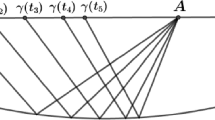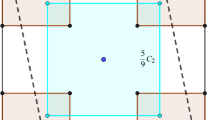Abstract
Sets of straight line segments with special structures and properties appear in various applications of geometric modeling, such as scientific visualization, computer-aided design, and medical image processing. In this paper, we derive sharp upper and lower bounds on the number of intersection points and closed regions that can occur in sets of line segments with certain structure, in terms of the number of segments. In particular, we consider sets of segments whose underlying planar graphs are Halin graphs, cactus graphs, maximal planar graphs, and triangle-free planar graphs, as well as randomly produced segment sets.










Similar content being viewed by others
Notes
A graph is maximal outerplanar if it has a plane embedding in which all vertices belong to the outer face, and adding any edge to the graph causes it to no longer have this property.
We use this nomenclature instead of triangle-free graph in order to avoid confusion between geometric and graph theoretic triangles.
The nomenclature is derived from Buffon’s Needle Problem, which investigates the probability that a needle will fall on a line when dropped on a sheet with equally spaced lines.
References
Balaban IJ (1995) An optimal algorithm for finding segment intersections. In Proceedings of the eleventh annual symposium on computational geometry, pp. 211–219
Ben-Moshe B, Dvir A, Segal M, Tamir A (2012) Centdian computation in cactus graphs. J Gr Algorithms Appl 16(2):199–224
Bentley JL, Ottmann TA (1979) Algorithms for reporting and counting geometric intersections. IEEE Trans Computers 9:643–647
Bose P, Maheshwari A, Morin P, Morrison J, Smid M, Vahrenhold J (2007) Space-efficient geometric divide-and-conquer algorithms. Comput Geom 37(3):209–227
Brévilliers M, Chevallier N, Schmitt D (2007) Triangulations of line segment sets in the plane. In International conference on foundations of software technology and theoretical computer science, pp. 388–399
Brimkov B (2017) On sets of line segments featuring a cactus structure. In International workshop on combinatorial image analysis, pp. 30–39
Brimkov B, Hicks IV (2017) Memory efficient algorithms for cactus graphs and block graphs. Discrete Appl Math 216:393–407
Brimkov VE (2013) Approximability issues of guarding a set of segments. Int J Computer Math 90(8):1653–1667
Brimkov VE, Leach A, Mastroianni M, Wu J (2011) Guarding a set of line segments in the plane. Theor Computer Sci 412(15):1313–1324
Brimkov VE, Leach A, Wu J, Mastroianni M (2012) Approximation algorithms for a geometric set cover problem. Discrete Appl Mathematics 160:1039–1052
Chan TM, Chen EY (2010) Optimal in-place and cache-oblivious algorithms for 3-d convex hulls and 2-d segment intersection. Comput Geom 43(8):636–646
Chazelle BM (1983) Reporting and counting arbitrary planar intersections. Report CS-83-16, Department of Computer Science, Brown University, Providence, RI, USA
Chen EY, Chan TM (2003) A space-efficient algorithm for line segment intersection. In: Proceedings of the 15th Canadian conference on computational geometry, pp. 68–71
Cornuéjols G, Naddef D, Pulleyblank WR (1983) Halin graphs and the travelling salesman problem. Math Program 26(3):287–294
Dujmović V, Eppstein D, Suderman M, Wood DR (2007) Drawings of planar graphs with few slopes and segments. Comput Geom 38(3):194–212
de Castro N, Cobos FJ, Dana JC, Márquez A, Noy M (2002) Triangle-free planar graphs and segment intersection graphs. J Gr Algorithms Appl 6(1):7–26
Durocher S, Mondal D (2018) Drawing plane triangulations with few segments. Comput Geom 77:40–45
Eppstein D (2016) Simple recognition of Halin graphs and their generalizations. J Gr Algorithms Appl 20(2):323–346
Francis MC, Kratochvíl J, Vyskočil T (2012) Segment representation of a subclass of co-planar graphs. Discrete Math 312(10):1815–1818
Green B, Tao T (2013) On sets defining few ordinary lines. Discrete Comput Geom 50(2):409–468
Harary F, Uhlenbeck G (1953) On the number of Husimi trees: I. Proc Nat Acad Sci 39:315–322
Horton SB, Parker RG (1995) On Halin subgraphs and supergraphs. Discrete Appl Math 56(1):19–35
Husimi K (1950) Note on Mayers’ theory of cluster integrals. J Chem Phys 18:682–684
Igamberdiev, A, Meulemans W, Schulz A (2015) Drawing planar cubic 3-connected graphs with few segments: algorithms and experiments. In International symposium on graph drawing and network visualization, pp. 113–124
Kára J, Kratochvíl J (2006) Fixed parameter tractability of independent set in segment intersection graphs. In International workshop on parameterized and exact computation, pp. 166–174
Kariv O, Hakimi SL (1979) An algorithmic approach to network location problems. I: the p-center. SIAM J Appl Math 37(3):513–538
Koontz WLG (1980) Economic evaluation of loop feeder relief alternatives. Bell Syst Tech J 59(3):277–281
Kumar CP (2019) On the regions formed by the diagonals of a convex polygon. arXiv:1904.04065
Mairson HG, Stolfi J (1988) Reporting and counting intersections between two sets of line segments. In: Earnshaw RA (ed) Theoretical foundations of computer graphics and CAD. Springer, Berlin, pp 307–325
Oliveros D, O’Neill C, Zerbib S (2020) The geometry and combinatorics of discrete line segment hypergraphs. Discrete Math 343(6):111825
Poonen B, Rubinstein M (1998) The number of intersection points made by the diagonals of a regular polygon. SIAM J Discrete Math 11(1):135–156
Preparata F, Shamos MI (2012) Computational geometry: an introduction. Springer, New York
Rappaport D, Imai H, Toussaint GT (1990) Computing simple circuits from a set of line segments. Discrete Comput Geom 5(3):289–304
Samee MAH, Alam MJ, Adnan MA, Rahman MS (2008) Minimum segment drawings of series-parallel graphs with the maximum degree three. In International symposium on graph drawing, pp. 408–419
Sysło MM, Proskurowski A (1983) On Halin graphs. In: Graph theory, Springer, Berlin, pp 248–256
Tiernan JC (1970) An efficient search algorithm to find the elementary circuits of a graph. Commun ACM 13:722–726
Vahrenhold J (2007) Line-segment intersection made in-place. Comput Geom 38:213–230
Wagner K (1936) Bemerkungen zum Vierfarbenproblem. Jahresbericht der Deutschen Mathematiker-Vereinigung 46:26–32
Acknowledgements
We thank two anonymous referees for their helpful suggestions which helped improve the paper. We thank Edinah Gnang for suggesting the study of Buffon segments and Stephen Hartke for several useful discussions. This work is partially supported by NSF-DMS Grants 1603823 and 1604458.
Author information
Authors and Affiliations
Corresponding author
Additional information
Publisher's Note
Springer Nature remains neutral with regard to jurisdictional claims in published maps and institutional affiliations.
Rights and permissions
About this article
Cite this article
Brimkov, B., Geneson, J., Jensen, A. et al. Intersections and circuits in sets of line segments. J Comb Optim 44, 2302–2323 (2022). https://doi.org/10.1007/s10878-021-00731-3
Accepted:
Published:
Issue Date:
DOI: https://doi.org/10.1007/s10878-021-00731-3




